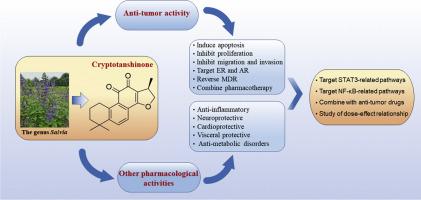当前位置:
X-MOL 学术
›
Fitoterapia
›
论文详情
Our official English website, www.x-mol.net, welcomes your feedback! (Note: you will need to create a separate account there.)
Cryptotanshinone: A review of its pharmacology activities and molecular mechanisms.
Fitoterapia ( IF 2.5 ) Pub Date : 2020-05-20 , DOI: 10.1016/j.fitote.2020.104633 Yan-Hong Wu 1 , Yu-Rui Wu 1 , Bo Li 1 , Zhu-Yun Yan 1
Fitoterapia ( IF 2.5 ) Pub Date : 2020-05-20 , DOI: 10.1016/j.fitote.2020.104633 Yan-Hong Wu 1 , Yu-Rui Wu 1 , Bo Li 1 , Zhu-Yun Yan 1
Affiliation

|
As a natural quinone compound, the medicinal value of cryptotanshinone (CT) has received increasing attentions, but there is no systematic literature review that describes the pharmacological activity of CT. This paper reviewed the pharmacology research of CT, with a primary focus on its anti-tumor activity. We also discussed the underlying molecular mechanisms, and proposed future outlooks. In addition to anti-tumor activity, CT was found to have anti-inflammatory, neuroprotective, cardioprotective, visceral protective, anti-metabolic disorders and other abilities. Furthermore, the potential molecular mechanisms contributing to the anti-tumor effect of CT likely involve the following aspects: the induction of apoptosis, targeting of ER and AR, reversion of MDR, combined pharmacotherapy, and the inhibition of cell proliferation, migration, and invasion. We also found that different pharmacological effects involved various signaling pathways. Among them, STAT3-related signaling pathways played a vital role in the CT-mediated induction of tumor cell apoptosis and proliferation, while NF-κB signal pathway also was essential for inhibition of inflammation by CT. Furthermore, CT could significantly enhance the activities of several anticancer drugs and reverse their resistances in tumors. Therefore, we proposed suggestions for future studies of CT, including enhancing anti-tumor activity by targeting STAT3-related receptors, targeting NF-κB-related pathways to inhibit inflammatory responses, enhancing anti-tumor efficacy by combining with anti-tumor drugs, and further studying the dose-effect relationship to ensure safer and more effective applications of CT.
中文翻译:

隐丹参酮:其药理活性和分子机制的审查。
作为一种天然的醌类化合物,隐丹参酮(CT)的药用价值受到越来越多的关注,但尚无系统的文献报道描述CT的药理活性。本文综述了CT的药理学研究,主要关注其抗肿瘤活性。我们还讨论了潜在的分子机制,并提出了未来的展望。除了抗肿瘤活性外,CT还具有抗炎,神经保护,心脏保护,内脏保护,抗代谢紊乱和其他功能。此外,促成CT抗肿瘤作用的潜在分子机制可能涉及以下几个方面:诱导细胞凋亡,靶向ER和AR,逆转MDR,联合药物治疗以及抑制细胞增殖,迁移,和入侵。我们还发现,不同的药理作用涉及各种信号通路。其中,STAT3相关信号通路在CT介导的肿瘤细胞凋亡和增殖诱导中起着至关重要的作用,而NF-κB信号通路对于CT抑制炎症也至关重要。此外,CT可以显着增强几种抗癌药的活性并逆转其在肿瘤中的耐药性。因此,我们为CT的未来研究提出了一些建议,包括通过靶向STAT3相关受体增强抗肿瘤活性,靶向NF-κB相关途径来抑制炎症反应,与抗肿瘤药物联合提高抗肿瘤功效以及进一步研究剂量效应关系,以确保更安全,更有效地应用CT。我们还发现,不同的药理作用涉及各种信号通路。其中,STAT3相关信号通路在CT介导的肿瘤细胞凋亡和增殖诱导中起着至关重要的作用,而NF-κB信号通路对于CT抑制炎症也至关重要。此外,CT可以显着增强几种抗癌药的活性并逆转其在肿瘤中的耐药性。因此,我们为CT的未来研究提出了一些建议,包括通过靶向STAT3相关受体增强抗肿瘤活性,靶向NF-κB相关途径来抑制炎症反应,与抗肿瘤药物联合提高抗肿瘤功效以及进一步研究剂量效应关系,以确保更安全,更有效地应用CT。我们还发现,不同的药理作用涉及各种信号通路。其中,STAT3相关信号通路在CT介导的肿瘤细胞凋亡和增殖诱导中起着至关重要的作用,而NF-κB信号通路对于CT抑制炎症也至关重要。此外,CT可以显着增强几种抗癌药的活性并逆转其在肿瘤中的耐药性。因此,我们为CT的未来研究提出了一些建议,包括通过靶向STAT3相关受体增强抗肿瘤活性,靶向NF-κB相关途径来抑制炎症反应,与抗肿瘤药物联合提高抗肿瘤功效以及进一步研究剂量效应关系,以确保更安全,更有效地应用CT。
更新日期:2020-05-20
中文翻译:

隐丹参酮:其药理活性和分子机制的审查。
作为一种天然的醌类化合物,隐丹参酮(CT)的药用价值受到越来越多的关注,但尚无系统的文献报道描述CT的药理活性。本文综述了CT的药理学研究,主要关注其抗肿瘤活性。我们还讨论了潜在的分子机制,并提出了未来的展望。除了抗肿瘤活性外,CT还具有抗炎,神经保护,心脏保护,内脏保护,抗代谢紊乱和其他功能。此外,促成CT抗肿瘤作用的潜在分子机制可能涉及以下几个方面:诱导细胞凋亡,靶向ER和AR,逆转MDR,联合药物治疗以及抑制细胞增殖,迁移,和入侵。我们还发现,不同的药理作用涉及各种信号通路。其中,STAT3相关信号通路在CT介导的肿瘤细胞凋亡和增殖诱导中起着至关重要的作用,而NF-κB信号通路对于CT抑制炎症也至关重要。此外,CT可以显着增强几种抗癌药的活性并逆转其在肿瘤中的耐药性。因此,我们为CT的未来研究提出了一些建议,包括通过靶向STAT3相关受体增强抗肿瘤活性,靶向NF-κB相关途径来抑制炎症反应,与抗肿瘤药物联合提高抗肿瘤功效以及进一步研究剂量效应关系,以确保更安全,更有效地应用CT。我们还发现,不同的药理作用涉及各种信号通路。其中,STAT3相关信号通路在CT介导的肿瘤细胞凋亡和增殖诱导中起着至关重要的作用,而NF-κB信号通路对于CT抑制炎症也至关重要。此外,CT可以显着增强几种抗癌药的活性并逆转其在肿瘤中的耐药性。因此,我们为CT的未来研究提出了一些建议,包括通过靶向STAT3相关受体增强抗肿瘤活性,靶向NF-κB相关途径来抑制炎症反应,与抗肿瘤药物联合提高抗肿瘤功效以及进一步研究剂量效应关系,以确保更安全,更有效地应用CT。我们还发现,不同的药理作用涉及各种信号通路。其中,STAT3相关信号通路在CT介导的肿瘤细胞凋亡和增殖诱导中起着至关重要的作用,而NF-κB信号通路对于CT抑制炎症也至关重要。此外,CT可以显着增强几种抗癌药的活性并逆转其在肿瘤中的耐药性。因此,我们为CT的未来研究提出了一些建议,包括通过靶向STAT3相关受体增强抗肿瘤活性,靶向NF-κB相关途径来抑制炎症反应,与抗肿瘤药物联合提高抗肿瘤功效以及进一步研究剂量效应关系,以确保更安全,更有效地应用CT。











































 京公网安备 11010802027423号
京公网安备 11010802027423号